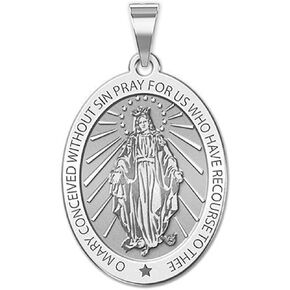- Shopping, made easy.
- /
- Get the app!
CHAIN IS NOT INCLUDED Available in Solid 14K Yellow or White Gold, or Sterling Silver Size Reference: 17mm is the size of a US dime 19mm is the size of a US nickel 25mm is the size of a US quarter Saint Eulalia co-patron saint of Barcelona, was a 13-year-old Roman Christian virgin who suffered martyrdom in Barcelona during the persecution of Christians in the reign of emperor Diocletian. There is some dispute as to whether she is the same person as Saint Eulalia of Mrida, whose story is similar. Relief of Eulalia by Bartolom Ordez in the Cathedral of Santa Eulalia. For refusing to recant her Christianity, the Romans subjected her to thirteen tortures; including: Putting her into a barrel with knives (or glass) stuck into it and rolling it down a street (according to tradition, the one now called Baixada de Santa Eulalia "Saint Eulalias descent"). Cutting off her breasts Crucifixion on an X-shaped cross. She is depicted with this cross, the instrument of her martyrdom. Finally, decapitation. Stylized X-shaped Cross of Santa Eulalia in LHospitalet Painting in Barcelona Cathedral of St. Eulalia with the X-shaped "cross saltire" A dove flew from her neck after decapitation. This is one point of similarity with the story of Eulalia of Mrida, in which a dove flew from the girls mouth at the moment of her death. In addition, Eulalia of Mridas tortures are sometimes enumerated among the Barcelona martyrs, and the two were similar in age and year of death. Eulalia is commemorated with statues and street names throughout Barcelona.Her body was originally interred in the church of Santa Maria de les Arenes (St. Mary of the Sands; now Santa Maria del Mar, St. Mary of the Sea). It was hidden in 713 during the Moorish invasion, and only recovered in 878. In 1339, it was relocated to an alabaster sarcophagus in the crypt of the newly built Cathedral of Santa Eulalia
 Picturesongold.com Miraculous Medal Necklace Catholic Virgin Mary Pendant Oval Pendants for Women & Men Crafted in 10K/14K Yellow or White Gold & Sterling Silver Christian Gifts for Men & Women or First Communion Gifts for Boys or Girls
KWD 16.500
Picturesongold.com Miraculous Medal Necklace Catholic Virgin Mary Pendant Oval Pendants for Women & Men Crafted in 10K/14K Yellow or White Gold & Sterling Silver Christian Gifts for Men & Women or First Communion Gifts for Boys or Girls
KWD 16.500
 PicturesOnGold.com 3D Firefighter Helmet with Badge Number & Department in Solid Sterling Silver, Solid 14k Gold, or Stainless Steel
KWD 25
PicturesOnGold.com 3D Firefighter Helmet with Badge Number & Department in Solid Sterling Silver, Solid 14k Gold, or Stainless Steel
KWD 25
 PicturesOnGold.com Saint Homobonus Religious Medal - 2/3 Inch Size of Dime, Sterling Silver
KWD 16.500
PicturesOnGold.com Saint Homobonus Religious Medal - 2/3 Inch Size of Dime, Sterling Silver
KWD 16.500
 PicturesOnGold.com Miraculous Medal Oval Pendant - 1/2 Inch X 2/3 Inch - Sterling Silver
KWD 12.500
PicturesOnGold.com Miraculous Medal Oval Pendant - 1/2 Inch X 2/3 Inch - Sterling Silver
KWD 12.500